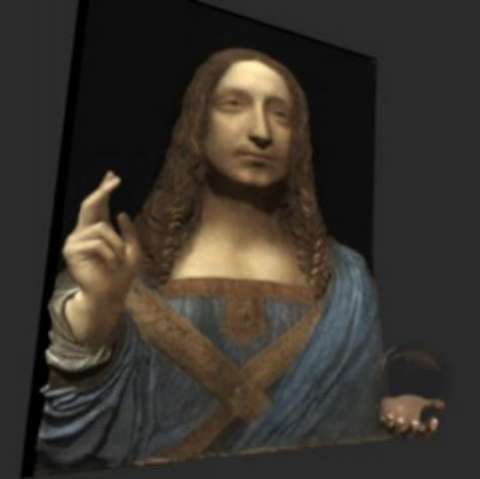
The implausible image of a glass globe in Christ’s left hand is far from the only rebuke from those who do not believe in the authenticity of the most expensive painting sold at auction ever. But it’s very painful. A glass or crystal ball (a metaphor for a saved world) on a walnut board for $450,312,500 almost does not refract light. A real ball of this shape would give the effect of a convex lens. A transparent object on the board looks flat. The folds of clothes behind it are not distort. That is, they are written without taking into account the laws of optics, in which Leonardo was an expert. And why would da Vinci do this — this is one of the most difficult questions for the defenders of the authenticity of the picture.
But recently, software scientists from the University of California at Irvine came to their rescue. Marco Zhanhang Liang, Michael T. Goodrich, and Shuang Zhao made a three-dimensional model of the composition “Salvator Mundi” and put forward the following explanation: there is not a ball in the left hand, but a sphere hollow inside. In this case, the refraction of the light will be minimal, and the background behind the ball (clothes) will not be distorted. As evidence, the researchers presented hollow-sphere renderings for the same composition.
The spherical shape explains the collision with the palm that shines through the glass surface. True, in this case, the image no longer has enough credible glare and reflections. However, the defenders have an explanation for this case too: they say that the image does not always have to be naturalistic. The laws of nature can be sacrificed when it is justified by an artistic design and special symbolic meaning. Indeed, naturalistic details will not give the viewer anything new. The artist's task is to reflect the solemnity of the moment. And it does not matter what is happening there with refraction in a crystal ball or how accurately is the effect of refraction at the boundary of the media for the feet of John the Baptist standing in the waters of the Jordan.
Okay. Never mind, never mind.
The location of the most expensive painting of the world is currently officially unknown. Contrary to expectations, it was not provided at the most important exhibition of Leonardo in the Louvre. Prior to the phenomenal sale at Christie's in 2017, it was considered for many years as a work by Leonardo's apprentice. In the 2000s, it was bought for $10,000, then Yves Bouvier bought it from investors for $80,000,000 to resell to Dmitry Rybolovlev for $127.5 million (according to unofficial data). After a scandalous trial with his dealer (the courts are still ongoing), Dmitry Rybolovlev sold a significant part of his collection, including “Salvator Mundi”. Now Rybolovlev is passionate about creating environmentally friendly infrastructure on his paradise Greek island of Scorpios, which used to belong to Aristotle Onassis and Jacqueline Kennedy.
Sources: artnet.com, rua.gr
- Log in to post comments










